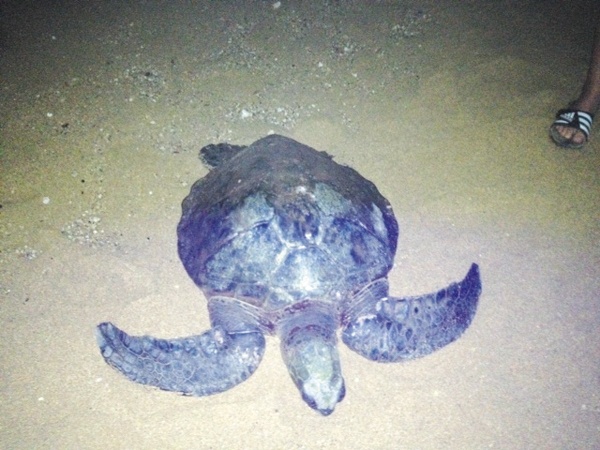LIHUE — A juvenile green sea turtle was euthanized Monday after it washed ashore near Princeville, entangled in a derelict gill net. Kauai District Fisheries Biologist Don Heacock said local veterinarian Scott Sims first responded to the Pali Ke Kua
LIHUE — A juvenile green sea turtle was euthanized Monday after it washed ashore near Princeville, entangled in a derelict gill net.
Kauai District Fisheries Biologist Don Heacock said local veterinarian Scott Sims first responded to the Pali Ke Kua area Sunday evening to find the 80-pound animal with two broken flippers.
“This animal is suffering,” Heacock said by phone Monday morning. “There is no way it can be fixed.”
X-rays taken Monday morning by Sims showed that the monofilament net, made from a single fiber of plastic, had cut through the scales, muscles and bones of both the turtle’s front flippers, leaving it unable to move, according to Heacock.
It was unclear exactly how long the animal had been trapped, but Heacock said it could have been weeks or even months.
“Once I saw the X-ray I thought for sure the best thing to do would be to euthanize it,” Heacock said.
Sea turtles depend upon their front flippers for 100 percent of their locomotion, and use their back flippers to steer.
“If the honu would have had only one virtually severed front flipper, we could have amputated it and the animal could have lived a long and relatively healthy life — except that it would not be able to breed if a male, and would not be able to lay eggs easily if it were a female,” Heacock said.
Sims kept the turtle at his facility overnight until he and Heacock received the go-ahead from George Balazs, team leader of the Marine Turtle Research Program, to euthanize the animal around 11 a.m.
Heacock said it was the humane and pono thing to do.
The turtle’s body will be frozen and sent to the National Marine Fisheries Service in Honolulu for subsequent autopsy — which will determine the animal’s age and sex.
“This is one valuable thing you can get out of a dead turtle,” Heacock said. “This will provide us with data where we can correlate length and size with age.”
Heacock said gill nets are used all over the Pacific, and that it was unclear whether the debris originated from Kauai, Hawaii or somewhere else, such as Russia or Japan.
One solution to the ongoing problem of entanglement, according to Heacock, is to use material that breaks down easier.
“If gill nets were made from natural fiber material — cotton or hemp — it would lessen the amount of ‘ghost fishing’ from lost fishing gear because if natural fiber nets are lost, the fibers break down relatively fast as compared to monofilament line.”
Heacock said he responds to similar strandings — whether it be an entanglement of vessel strike — at least once a month.
“And here’s the kicker — we’re only seeing the tip of the iceberg,” he said. “The ocean is drowning in marine debris, and we’ve got to realize that it’s just not sustainable.”
Sims could not be reached for comment by press time.
All fishers and beach users are encouraged to pick up and dispose of derelict netting, line or ropes found on the beach. Large pieces of debris should be reported to either the DLNR Division of Aquatic Resources at 645-0532 or the Surfrider Foundation of Kauai.
• Chris D’Angelo, environment writer, can be reached at 245-0441 or cdangelo@thegardenisland.com.


